
51 minute read
Real Estate
Charlotte’s real estate market remains as dynamic as it did prior to March 2020. A booming housing market, solid corporate expansions and relocations, piping hot industrial demand and solid suburban segments are among the bright spots for the sector.

Advertisement




Getting hotter:
Despite challenges, Queen City real estate proved resilient in the face of the health crisis
The COVID-19 pandemic undoubtedly rearranged the socioeconomic landscape of the nation, and world, accelerating underlying real estate trends and disrupting the notions of dwellings and commercial spaces in the process. In Charlotte, the intersection of Trade and Tryon, arguably the heart of the Queen City’s central business district, likely has never seen such a debilitating suspension of overall activity prior to the onset of the coronavirus. Mandated shelter-inplace measures quickly ceased activity in the region’s sprawling Uptown, Southend and Central City areas. Parts of Charlotte, marked by beautiful trophy buildings and idyllic live-work-play environments, sat eerily empty for most of 2020 as corporations, businesses and individuals faced life in the “new normal.”
The initial shock of the health crisis dampened a strong start to the first quarter in terms of sales and deals for both the residential and commercial real estate sectors. The weeks following March 2020 were ripe with uncertainty as individuals and government, health and business leaders grappled with an unprecedented pandemic. Yet, Charlotte’s decadelong period of growth in terms of development and in-migration, headquarter relocation culture, and economic diversification anchored by its strong banking and finance sector proved undeterred in the face of this black swan event.
As such, the Queen City’s real estate sector saw significant milestones in a year marred by the ongoing health crisis. Significant new projects broke ground, accounting for hundreds of millions in investment dollars. The city’s corporate relocation/ expansion culture pulled in its fair share of corporate heavyweights over the last year, with Centene and Robinhood among those planting their flag in the Queen City in the midst of the pandemic. Changing consumer buying patterns are steering the growth and demand in the industrial real estate sector, which land availability and a robust infrastructure system in Charlotte and surrounding counties can readily accommodate. Additionally, the ability to work from home mixed with ultra-low interest rates bolstered an already dynamic residential housing market and is slated to support growth in family-friendly, suburban markets outside of Charlotte proper, such as Union, Gaston and Lancaster counties.
Across asset classes, the pandemic has both ( )
Bullish
Flexible opportunities will emerge in the office segment but talk of the sector’s demise is premature
Clay Grubb
CEO – Grubb Properties
In what ways has the pandemic altered the o cespace environment? Anybody who thinks that the fundamental use of office space has dramatically changed is kidding themselves. At the end of the day, most folks are anxious to get back and see their colleagues and experience the watercooler conversations that you can’t get when you’re at home alone. I do think there’ll be more flexible opportunities available but we’re quite bullish on the future of office spaces. We’re actually setting ourselves up to develop the most office that we’ve developed in probably 20 years. At the end of this past year, we signed the second-largest lease in our history: a 200,000-plus-square-foot, 15-year lease with a Fortune 2000 company, and they’re expanding. Great companies are going to have great office space. The mom-and-pops that have four or five employees and 1,500 square feet might not need office space. A lot of these smaller tenants have gone away and they might not come back. But larger corporations, anybody who relies on teams, are going to need space.
How does the 2021 Grubb Qualified Opportunity Fund enable opportunities across the country? At the end of the day, the Opportunity Zone program was created to spur activity in low-income Census tracts. In urban markets, I think it’s been successful. You’ve seen a fair amount of housing development shift toward these neighborhoods. That’s forcing people to build a more value-based product. The reality is, there’s a huge shortage of housing, especially valuebased, in America. Forty percent of Americans can’t afford the average price of a new apartment in this country. Our focus on essential housing is intended to address that. What is your near-term outlook for real estate? Residential is going to be really strong. The demand is huge. Charlotte had close to 100 people a day moving here pre-COVID. I think there will be even more in the future. I do think 2021 is going to be a very challenging year for office. You have a major company here in Charlotte where the CEO sent out a memorandum saying that the company wants to reduce office space by 25% because of remote working. They’re going to implement that program, probably to the detriment of morale and a lot of other things, and 18 months from now, they’re going to wake up and say, wow, that was a really bad idea. I think companies that are thinking in a contrarian way are locking down great long-term deals on office space, and they’re going to need it. A year and a half from now, it’s going to be in high demand.

Johno Harris
President Lincoln Harris

What have been your primary takeaways from the shift to remote working?
We went remote in mid-March 2020, and we’ve watched closely as our productivity has remained high. All of the companies and clients we deal with will go through a similar evaluation as the pandemic subsides to determine whether some part of their business can continue working from home. Maybe not because they are trying to save costs, but rather as an insurance policy relative to the disruption of their business. In our case, we had our whole accounting team working from home within a week. It still works fairly well. There will be di erent avenues of business that may continue to work from home, but if you look at businesses that rely on collaboration and people being around each other, you can’t replicate that on a Zoom call. In some form or fashion o ce space needs will change, but we believe the continued demand will be there as we come out of the pandemic.

In what ways has COVID-19 added a new layer of complexity to the construction industry?
We have implemented strict CDC-recommended protocols to operate sites in the safest way possible. A benefit has been when materials are in close proximity, we have been able to get them to the job quicker because there is not as much tra c or disruption on the last-mile supply chain. On the first-mile supply chain, however, we witnessed significant disruptions.
What are your near-term expectations?
Service has always been at the core of our business, whether that is the corporate service side of the business, management or development. We strive to service our clients at the highest levels. For 2021, as vaccinations continue, we believe Charlotte and the Sun Belt are both poised to have a great run for the next five to 10 years. On the corporate service side, we have to continue to be nimble and flexible to flow evenly with our clients and their needs, which change daily and at a heightened pace.
More than $3 billion in investments and developments are planned for Charlotte’s Center City for 2021 and beyond.
( ) challenged the real estate sector while creating new opportunities for innovation and growth in a post-pandemic world. Fueled by a continued population inflow, attractive job opportunities, and capital investments, the Queen City has rolled with the punches created by the health crisis, which bodes well for business and individuals and the places where they live, work and play.
Residential In Charlotte, while commercial real estate contends with some COVID-related uncertainty, the housing market has experienced a record-breaking boom throughout the pandemic landscape.
Charlotte was a hotbed for in-migration well before the pandemic as individuals arrived in the region attracted by the area’s affordability and job

opportunities. According to census estimates released last May, Charlotte added nearly 13,200 residents from July 2018 to July 2019, a 1.5% increase, the Charlotte Observer reported. The population growth has placed Charlotte as the 15th-most populous city in the country, according to May 2020 census estimates. Over the last decade, population growth stands at 19.9% from 731,400 in 2021 to 885,700 as of July 2019, the newspaper reported.
The coronavirus dampened the desire to live in densely populated markets while fueling the drive to live in growing, affordable and tax-friendly markets like Charlotte. The region’s strong corporate culture mixed with the added benefits of remote work make Charlotte among the desirable Sun Belt destinations, capturing in-migration from the Northeast and West Coast.
Throughout the current housing market cycle, homebuyers have grappled with record-low inventory levels, rising home prices, and bidding wars. The strong demand for housing has led to a steady increase in prices for real estate across North Carolina and Charlotte alike. North Carolina saw an 11.4% year-over-year price gain in the fourth quarter of 2020, according to the Urban Institute. This is almost double the 6.4% growth rate the state saw in the fourth quarter of 2019. Deeming the sector essential was critical for the success of Charlotte and the state’s housing market. The supply of homes for sale in the Charlotte MSA reached critical lows, according to various industry reports. Current housing supply as of April 2021 in Charlotte stands at a little more than two weeks of inventory available, a sign of a hot residential housing market, Norada Real Estate ( )

®oundtable:
Demand drivers
Limited inventory, remote work and the demand for open spaces are among the drivers changing the residential segment. Leaders in the sector weigh in.
Daniel Cottingham
CEO Cottingham Chalk
What are the main factors driving the real estate market in the last few months? With inventory limited and interest rates so low, it’s a great time to be selling a house because those factors translate into higher prices. We have also seen new demand from people moving here from other markets and people who have new housing needs due to the pandemic. When people are stuck at home for months on end – working from home, learning from home, playing at home – their needs change. The buyers who are successful in bidding wars are comfortable moving quickly. They have educated themselves on the market and have a very good agent in their corner.
To what extent are sellers willing to put their properties on the market right now? That is one piece of the inventory shortage. There is certainly a segment of the population that would consider selling under normal conditions, but they are not yet comfortable with buyers coming through their house.
What are your expectations for the residential space? From a long-term perspective, we are in a great position as both individuals and companies see Charlotte as an enticing place to live. Companies continue to invest here, and our local leaders recognize the importance of responsible growth. There are challenges ahead, no doubt – public transit and a ordable housing most notably – but Charlotte is committed to addressing these through its long tradition of public/private partnerships.
Valerie Mitchener
Owner HM Properties
Which factors are influencing the residential market in Charlotte? The most significant factor driving our market is simply the number of people wanting to move here. Charlotte keeps moving up in the ranks for the top places to live as compared to other U.S. cities, which has been a big boost for us. The primary reason people used to move to Charlotte was a job transfer or to be near family. In 2020, the buyer profile that stands out the most is the buyer moving just to move and wanting to be in Charlotte.
What e orts should be made to increase inventory in the city? The only way that we can have more inventory is to build more units including both single and multifamily. Building more houses is challenging because of supply issues and a limited labor force. I think we are going to have this problem in Charlotte for a while. This is not going away in 2021.
How is the rental market performing? The rental market is strong and consistent. The lack of inventory has made temporary housing a huge commodity. As people from all over the country relocate to Charlotte, the demand for rentals has increased. There are new apartment complexes being built to accommodate the influx of residents. Existing complexes have limited availability. There is also a large percentage of the population interested in renting single-family homes which are even more challenging to find. As long as our inventory remains low, the rental market will continue to be strong.
John Porter
President Charter Properties
What impact did the pandemic have on rental rates? Where we operate in suburban locations, the impact was negligible in terms of any negative impact. We still continued to get modest rent increases depending on the market but we’re primarily in suburban environments so occupancies are very strong and rents continue to be good. We get a lot of tra c in the suburban locations.
How has work from home a ected how you design and size your units? What we’re seeing is that our smaller units need to get bigger and our larger units are probably fine. We have been out there building units for some time that are today called “build to rent.” That’s not a new product for us, but that’s becoming a hot topic, with people building single-family homes much more and townhouses for rent. We’ve been doing a townhouse rental product for many years as part of a larger apartment development. We’ve expanded our o erings in that regard over the years and we’re still doing that. We think that those are particularly well-suited to those who want less dense circumstances but still have something that feels more like a house without having to buy and own something and have that expense. We’re also thinking about how people want to access our product. They’re far more comfortable doing it electronically than they were maybe a year or two ago. And there’s less of a need to do it in person; there’s certainly some things like relationship building that are really valuable in person but in terms of touring the unit, they can do it by video. They can even rent a unit electronically, so we’ve instituted that like most of our competitors for prospective residents. How has the pandemic impacted the shortage of supply in new listings? Pre-pandemic, we had a shortage of housing supply, primarily in medium and low-income neighborhoods. Interestingly, up until now, this trend has continued but the demand has accelerated in the higher-end properties. This can be explained by the companies and executives moving to Charlotte. Prices only continue to increase, buoyed by the lower interest rate mortgages. This is a perfect storm to bolster real estate prices but hopefully we’ll begin to see more supply coming to the market as the pandemic eases.
Which areas have been the most attractive? Mecklenburg County has always been attractive but we are seeing demand all over the Carolinas. The Rock Hill area and Lancaster County areas are growing well but Mecklenburg is certainly outperforming. I cannot pinpoint any area that has not benefited from this increased demand within the Charlotte MSA. People are now investing more in their homes. They are setting up o ces and investing in new equipment to enable them to perform their jobs from home. Given the investment people are making, it seems that the working from home trend will continue, especially since people have been just as productive working remotely. This is especially important when safety can be guaranteed and other aspects of life can work around corporate life. Home o ces should be a significant priority going forward but people still need to have a separation of work and home space. There will be an ongoing focus on a dedicated o ce space in residential constructions and renovations.
Yuriy Vaynshteyn
President & CEO Engel & Völkers Charlotte
The desire to move away from densely populated cities mixed with record low interest rates has sparked housing demand.
( ) reported in its 2021 Charlotte Real Estate Market & Investment Overview.
The ultra-low interest rate environment is another contributing factor in Charlotte’s housing boom. Homebuyers, lenders and industry professionals are closely monitoring a potential rise in rates, but given the overall economic climate, rates are likely to remain low for the foreseeable future, which bodes well for buyers. “Rates have never been this low, but whether or not they’re going to stay that way is another question,” Lake Norman-based Kate Gaither, Owner of Newport Properties, told Invest:. “When I started in this business, rates were 17% for a fixed mortgage. Now, we are under 3%. You can buy a lot more house for your money if you make that decision now.”
Charlotte has been identified by experts as a key market that will continue to attract in-migration and homebuilders in a post-COVID world. The Urban Institute’s 2021 Emerging Trends in Real Estate ranked the Queen City fifth in overall real estate prospects and 11th in homebuilding prospects. Similarly, a bevy of Charlotte neighborhoods topped Niche’s 2021 Best Places to Live rankings in North Carolina as Queen City neighborhoods dominated the review website’s Top 25 spots.
The combined factors of the remote work landscape, overall affordability compared to other markets, strong homebuyer demand and low supply are set to carry the Queen City’s residential market throughout 2021 and beyond. The dynamic residential market does pose challenges for economically embattled individuals who faced COVID-related job losses. Statewide eviction moratoriums have been extended through June 30, 2021, providing respite to renters


and homeowners experiencing economic hardship. However, affordable housing remains a top priority for public and private leaders in the Queen City.
Affordable housing The economic mobility challenge in Charlotte is an ongoing issue exacerbated by the current health crisis. The Charlotte city government estimates that more than 24,000 units of affordable housing are needed to meet the current demand, a goal that will need the concerted efforts of public and private partners to satisfy the need. The 2014 Chetty Study that ranked Charlotte last among the 50 largest U.S cities in terms of economic mobility remains fresh in the Queen City’s cultural zeitgeist. In response, nonprofit Leading on Opportunity was created in 2017 and is focused on affordable housing, early-childhood education and career preparedness and training together with a coalition of philanthropic and other nonprofit agencies, local government and major employers.
In 2020, voters overwhelmingly approved more than $200 million in General Obligation bonds earmarked for infrastructure improvements, affordable housing and local neighborhood rejuvenation projects. From the bonds, $102.7 million will be allocated to transportation, $50 million to affordable housing and $44.5 million to neighborhood improvements. Hailed as a key victory for Charlotte, these bonds demonstrate that the city is willing to make the necessary investments in infrastructure and housing stock to best further the city’s reputation as a great place to live, work and do business. The bond package is the fourth to pass after similar packages in 2014, 2016 and 2018.

Flint McNaughton
CEO & Founder SunCap Property Group

What are your observations regarding the manufacturing space?
We have seen certain industries and manufacturers hit the pause button, slowing down their decisionmaking process as they try to figure out what the final impact of the pandemic is going to be. The view out the windshield today is not as clear as it has been with the combined e ects of the virus, the presidential election and recent social strife. The incumbent administration’s policies, together with COVID-19, have triggered a wave of repatriation processes, particularly with the manufacturing arm of the pharmaceutical space. This trend is great for our business as we do a fair amount of work for automotive suppliers and manufacturers.

How would you gauge the performance of the multifamily market?
The key marketplaces where we are investing in multifamily, including Charlotte, Raleigh, Greenville and Charleston, are all growing significantly. There are 40 to 50 people a day moving into these communities, which translates into real demand for our product and what we are doing. Our typical multifamily projects consist of infill locations, more boutique and smaller, high-end projects. We have a thesis that there are people moving out of bigger, more expensive homes, in places such as Myers Park and Eastover in Charlotte, and that the market would seek out places such as SunCap’s Draper Place apartment community. Despite COVID-19, we are leased up and will be pulling the trigger on projects in these marketplaces. Long term, we do think demographers are going to be writing about this growth trend and migration to the Southeast and other Sun Belt states. Big companies are moving headquarters to these Southeastern cities and for good reason. Right to work states, high-quality workforce, growing communities, and great weather are just some of those reasons. And, Charlotte is at the epicenter of all that. We are bullish on Charlotte.
Housing a ordability remains a key priority for development, government and private sector leaders.
The private sector has played a pivotal role in funding affordable housing-related initiatives. Banking giant, Wells Fargo, for example, has invested more than $20 million over the years to help spur affordable housing opportunities in the region. “We also provided a $5 million equity grant to the Housing Opportunity Investment Fund to help match the city of Charlotte’s $50 million bond referendum,” Charlotte Regional President Kendall Alley told Invest:. “In addition, we’ve made more than $9 million in commitments to support local community development nonprofit organizations focused on addressing the issues of affordable housing, workforce development, smallbusiness development, financial empowerment and neighborhood revitalization in Charlotte.”
Similarly, in 2020, Charlotte-headquartered Bank of America and its Community Development Banking division provided a record $5.87 billion in nationwide loans, tax credit equity investments, and other

real estate development solutions to address the affordable housing need nationally and in the Queen City. Locally, the bank financed more than $40 million in housing in 2020, the Charlotte Business Journal reported.
Additional to funds created for new ground up construction of affordable housing projects, the preservation of existing housing stock is also a key component of maintaining affordability in the region. Traditionally, the affordable housing industry has been focused on new construction financed by lowincome housing tax credits. Local groups like Ascent Real Estate Capital are focused on preserving Naturally Occurring Affordable Housing (NOAH). “The thought process is that protecting existing affordable housing is as important as trying to create new units when trying to tackle the affordability crisis,” Managing Partner Jon Dixon told Invest:. “We purchase existing multifamily apartment complexes that are in the path of progress, being targeted by value-added groups. Through social impact capital (private) and low interest rate debt from the city’s Housing Trust Fund (public) we are able to buy a property that is vulnerable to losing its affordability and put longterm deed restrictions in place that maintain certain amounts of the units be leased at 30%-80% of area median income (AMI),” he said.
Public and private leaders are keenly aware of the need for housing affordability in the Queen City, especially as the population grows. Guided investments such as the General Obligation bonds mixed with private investment and creative solutions on behalf of the development communities will be key for the region’s affordability factor in a post-COVID future.
Multifamily On the multifamily front, Yardi Matrix’s Multifamily Report Winter 2021 showed that demand continues ( )
Brisk activity
Despite geographical and logistical challenges, Northwood Office continued to source new opportunities during the pandemic

What does the Metropolitan Complex project mean for Northwood O ce? Northwood’s investment and operational activities have been brisk during the pandemic. As a global private equity firm, our U.S.-based teams were able to anticipate early some of the challenges and opportunities related to the pandemic based in part upon the experience gleaned from our European properties, which endured the initial impact of the pandemic earlier than the United States did. Northwood’s four operating platforms (office, hotel, retail and multifamily) have continued to work closely with our acquisitions teams to source new investment opportunities throughout the duration of the pandemic, despite many geographical and logistical challenges impacting buyers and sellers alike.
The Metropolitan acquisition is a recent example of this collaborative, proactive investment approach during the disruption of the pandemic. This acquisition, which was coupled with the simultaneous purchase of two office buildings and a development parcel in suburban Nashville from the same seller, reinforced Northwood Investors’ strong commitment to Charlotte and the Sun Belt.
What is your take on the future of retail? Our retail platform continues to see a rapidly evolving retail landscape, which has been accelerated by the pandemic. As investors and operators, we are approaching the retail experience with an extreme focus on understanding and anticipating consumer behavior in the midst of a disruptive and relatively uncertain environment. As we think about Ballantyne Reimagined, we continue to revisit our design plans to ensure we provide what consumers and retailers want now and in the future. We are making spaces more open and accessible and providing more opportunities to spread out. The goal is to create spaces that are flexible and can accommodate different programming opportunities that can vary depending on the time of day or user.
What are your expectations for 2021? The health, well-being and safety of our team members and customers have always been paramount to Northwood. That was the case pre-pandemic and will continue to be so post-pandemic. Making sure we generate a reinvigorated corporate relocation pipeline to Charlotte will also remain top of mind, working together with the city and county’s economic development teams and the Charlotte Regional Business Alliance to bring more businesses here. There is significant opportunity for Charlotte, and when the region wins, we all win.
John Barton
President – Northwood Office
( ) to stay strong. In November, overall rents averaged $1,229, the report showed. Always considered as a safe investment, a total of $2.2 billion in multifamily assets traded in Charlotte in 2020, Yardi Matrix reported. As of November 2020, more than 14,000 units were under construction in Charlotte.
The pandemic accelerated the trend of population growth shifting from high-cost gateway cities to emerging markets throughout the Sun Belt, with Charlotte being among the most desired destinations for both individuals and corporations seeking to relocate. That’s according to JLL’s Better Than Normal: Vision 2021 report citing that 90% of population shifts since the onset of the pandemic have been driven by reduced housing costs.
The wave of homebuyers in Charlotte, buoyed by low interest rates, that has kept housing supply at record lows, pushing up prices, means renters with tighter budgets have been priced out and will likely continue to be renters in 2021 and beyond. Similarly to the challenges in the housing market, the multifamily space is also facing a shortage of inventory. Following the completion of 8,182 units in 2019, developers added only 4,310 units last year through November, Yardi Matrix reported. These challenges are likely to persist. As such, the pandemic’s impact is expected to increase demand for the Renter-by-Necessity product, according to Yardi Matrix.
The desire for outdoors space and improved working environments may translate to the multifamily front as well. “In multifamily, people may also want more access to outdoor space in their communities and space to work from home, not just in terms of square footage but also in terms of privacy,” Red Hill Ventures CEO Todd Collins told Invest:.
For developers, capitalizing deals amid a global pandemic has been a constant challenge. “Some banks are pushing in the clutch a little bit because of COVID, just unwilling to make some of the loans that they would have pre-COVID,” Selwyn Property Group Partner Grey Poole told Invest:. “Most observers would probably say that’s a short-term phenomenon but it’s one of the bigger challenges we see out there. A lot of it goes back to the fact that COVID has created a great deal of uncertainty and some people are just waiting to get to the other side of it.”
It is estimated that more than 72,000 apartment ( )
After completing 8,182 housing units in 2019, developers had added just 4,310 through November 2020

Darryl Dewberry
Chairman & CEO – The Spectrum Companies
The first of our two 11-story o ce buildings is scheduled to be delivered in early 2021. Our anchor tenant, Lending Tree, is building out its new o ces. The company is working remotely at the moment so its move-in date is still to be determined. Our team is negotiating a lease with a junior anchor as well, a highly prominent professional services firm. In addition, we are working on finalizing some food and beverage o erings. We are confident this first building will be fully leased in short order. The second building broke ground a couple of months ago and is scheduled for completion by the first quarter of 2022. We are in conversations with two di erent hotel groups to establish a signature hotel at the property as well.
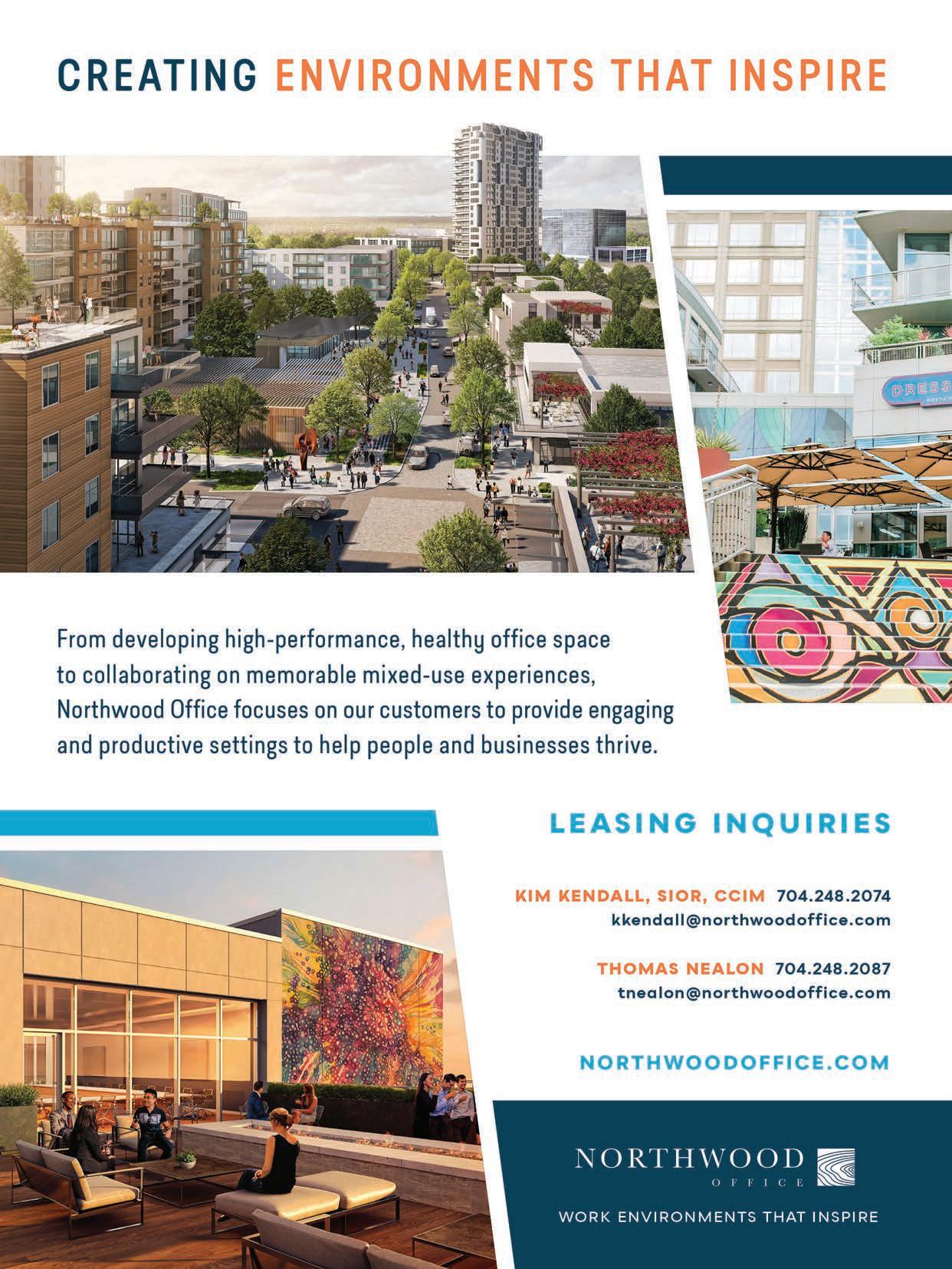
( ) units will be needed to meet market demand by 2030, the Yardi Matrix report pointed out, citing a study by the National Multifamily Housing Council and the National Apartment Association. Fortunately, despite the pandemic, Charlotte’s underlying fundamentals of population growth and strong economic base mixed with stabilizing unemployment rates bode well for the sector when factoring in market demand and the shortage of multifamily supply.
As the nation, and the Charlotte market, edge toward a post-COVID future, opportunities look ripe for investors wanting to fund the next wave of multifamily developments in the Queen City and for individuals seeking to maximize the familial and professional upside potential the market has to offer.
Commercial Of the major real estate asset classes, properties that fall under the commercial umbrella sans industrial, namely office, retail, and hospitality, were among the hardest hit by the pandemic, both nationally and locally. The rapid shift to remote work, changing consumer behaviors bolstered by the convenience of e-commerce and the initial lack of confidence in travel fueled the uncertainty in the commercial real estate market. Thankfully for the Queen City, the decade preceding the onslaught of the virus was characterized as the most prolific period in the Charlotte office, residential and hotel construction industry in the city’s history. Though shaken by the COVID-related challenges, this strong foundation has allowed the market to weather the storm and fuels the confidence of a robust recovery as 2021 carries on.
At the end of 2020, Charlotte’s business district saw a surge in sublease office space, and absorption decreased year over year. Leasing velocity ( )
Perspectives: Sectoral views
Allen Brown
Assistant Vice President – LRC Properties From an o ce standpoint, I don’t think the market is going to get better anytime soon. There are still too many unknowns. I think the suburban o ce market will come back before CBD simply from an accessibility standpoint. It is a lot easier to socially distance and access your o ce in a three- or fourstory building compared to having to ride an elevator in a large 40-story tower. Industrial will continue to stay hot.
Eb Moore
CEO – Wilkinson ERA Real Estate As information and protocols emerged, we safely began showing homes and as we entered the summer months, pent-up buyer demand drove the sellers’ market forward with considerable momentum. 2020 closed with one of our best years in the real estate business. Last year taught us to move forward despite the challenges and uncertainty that lie ahead.
John Nichols
President – The Nichols Company We’ve been focusing a lot on suburban land, which has been largely unexpected. I still think the urban corridors, which are ghost towns right now, will bounce back very quickly. People are still actively looking for property for apartment complexes and mixed-use buildings. The entry of the Silver Line to the area will change the landscape all the way from Independence up to the airport.
Cristy Nine
Corporate Managing Director, Charlotte – Savills In terms of activity, Downtown Charlotte is very quiet. There is definitely more activity in the suburbs, which is a function of the smaller-footprint client the suburbs tend to attract. It is too early to tell, though we believe Charlotte is one of the places that will benefit most from the urban outflows of people.
Larry Wilson
Regional President – KDC Real Estate Development & Investments Some retail assets have absolutely thrived in this environment, such as grocery stores. Others have been severely crippled to the point of improbable comeback. Whether that becomes asset repositioning or use modification remains to be determined. Opportunities will abound, no question.
®oundtable:
Commercial reflections
From industrial to mutlifamily, there were both challenges and opportunites in the Charlotte market. Leading players reflect on an unexpected year.
Greg Copps
What were some of the indicators for the company in 2020 and how have things shifted? We are strong in industrial and o ce brokerage and our year was led by these sectors. We have a good client base in industrial and that has gone through 2020 with no shortage of capital for investment properties and high demand for industrial land. Amazon is continuing to snap up space across the country and Charlotte is no exception. Some of the other retailers such as Target and Walmart are starting to build out their e-commerce supply chain too, but they still need to catch up. The o ce sector has slowed but creative deal making and solid relationships along with Charlotte being very well positioned continues to generate positive brokerage momentum. On the multifamily and retail side, the story is a little di erent, but our firm is quite nimble and entrepreneurial so even during downturns there are always ways to assist clients. During 2020, we had to work harder and di erently but we ended up experiencing a good year with positive revenue.
What are some of the new business lines introduced in 2020? We were focused more on expanding some of the tools we already had, including mapping, graphing and putting together virtual presentations. We wanted to leverage the overall Colliers platform to produce bestin-class materials. We now want to continue to build out our multifamily platform and our o ce agency business and hire best in class brokers in all disciplines. There is definitely room for growth in Charlotte for Colliers and we will continue to build out the team.
Brett Gray
Managing Principal Cushman & Wakefield – Charlotte
How has the Charlotte real estate market behaved in 2020 as compared to your expectations? I don’t think anyone predicted 2020 and the impacts the pandemic would have on the markets. 2019 was a record year for commercial real estate. Historically, Charlotte has been a very healthy market. We have not overbuilt like many other markets and coming into this year there was a significant amount of new development activity occurring. However, when you peel back that layer in the o ce market, for example, the majority of that was pre-leased. Our risk profile was far less than the square feet being developed on paper.
There’s no doubt that the Sun Belt has shown a great trend of growth and in-migration. In particular in Charlotte, we have access to the beach and mountains, great weather, fantastic quality of life, all with a belowaverage cost of living. When companies are looking at coming to Charlotte, all of these factors make it attractive to relocate here.
Do you see the trend of moving o ce space toward the suburbs staying in the long term? Charlotte has been experiencing reverse migration to a degree as millennials are starting to have families and move to the suburbs. However, I don’t believe there will be a massive trend of moving o ce space to the suburbs simply as a result of COVID-19. We are still going to see growth and development in what we call the urban core. At the end of the day, our Central Business District is still the engine that makes Charlotte’s economy go; it’s still our largest submarket. Therefore, we’ll continue to see growth in the area.
Chris Thomas
Partner Childress Klein
What were some of the highlights and milestones Childress Klein experienced in 2020? It was certainly an interesting year and there were many highlights. CK is a diversified organization with industrial, o ce, retail and multifamily developments. Some businesses have continued to thrive through this pandemic and some, like retail, have been more challenged. We’ve spent a lot of time in the past year with our tenants and we have proactively managed our portfolio. We are fortunate to have several long standing third-party leasing and management relationships that comprise part of our portfolio. We’ve met a lot of challenges working with our tenants in our centers. The great majority of our tenants are folks who we’ve known for a while and when they’re having di culties, we’re going to do our best to partner with them. We’ll continue to do this as we look for improvement in the second half of 2021.
How has COVID legislation a ected your tenants and changed your projections? I don’t necessarily believe it significantly altered our projections but it certainly was a lifeline to many of our tenants. As an industry, we depend on small business. As I work on retail developments, I can see that the consumer is less interested in certain chain stores and chain restaurants than they once were. People want to support interesting small businesses that provide an experience. So, the fact that our tenants who fit this mold were able to get that kind of help, I’m very grateful. I think it did make a di erence. We’ve seen tenants who have taken the attitude that they will survive this and rebuild what they have. How would you characterize the pandemic impact on the local market over last year? I think the biggest initial impact on the investment sales world is just uncertainty. During April and May of 2020 there were many questions regarding what was going to happen. The biggest sectors were retail, o ce and hospitality. Obviously, people were not going to work from the o ce and a lingering question is how that return will look in the long term. Things started to pick back up during September and October, and November and December yielded strong numbers for us last year. We had a better sense of what was going to happen. Tenants were still paying their rents and while we saw the closure of many businesses, it wasn’t the potential catastrophe that people thought it was going to be at the beginning of the pandemic. As we got used to the new normal, adjusting and gaining clarity led to a pick-up in transactions. Now, vaccines are rolling out and people are more comfortable wearing a mask and navigating things. At this point it feels like it did like in February before it all started.
How is the real estate market positioned now? The mentality among my agents and the investors that we work with is back to normal. In some sectors we saw a pricing correction, but it was not unreachable. A lot of people initially decided to wait and expected to buy in 4Q20 at a cheaper price but that was not the case. Multifamily cap rates and single-tenant rates actually compressed a little last year. Multifamily proved to be very durable. For central retailers there was a lot of safety perceived in those, their sales picked up and they managed the pandemic well.
Ben Yelm
Regional Manager, Charlotte Marcus & Millichap
( ) slowed and deal renewals capped off a tumultuous year, according to various industry reports. Total office vacancy hovers at 13%, according to JLL’s 2020 Q4 office report. Both direct and sublease asking rents remain flat staying at $32.56 per square foot and $29.54 per square foot, respectively, JLL reported. At the end of Q4, there was more than 1.1 million square feet of sublease space marketwide, according to JLL data. Industry experts expect more sublease space to become available throughout 2021, as companies reconsider and consolidate their commercial real estate needs.
Concessions remained on the rise, the JLL report noted, a common theme for commercial real estate as landlords and tenants navigated the uncertainties of the pandemic. “There have been new clauses added to leases for these unforeseen events,” Boundary Street Advisors Principal William Haygood III told Invest: regarding lease structures throughout the pandemic. “In this environment, there’s been a lot of attention to things like subleasing and our ability to help with landlord conversations about the flexibility of lease terms. The durations of the new leases have generally been the same, but you are finding more people moving to Plaza Midwood, West Charlotte, Freedom Drive, all places where we play, which is exciting for us,” he said.
While the developers, commercial brokers, and investors look forward to a strong recovery in 2021, the Charlotte region fared relatively better than other comparable markets and netted strong victories despite the pandemic.
In what has been hailed as the biggest economicdevelopment deal in North Carolina’s history, health-

HQ relocations by companies such as Centene and Robinhood were key wins for the commercial sector in a year marred by uncertainty.

Chase Monroe
Market Director – JLL Carolinas
Industrial real estate has been in a boom period. Industrial tenant demand is up 20-40% depending on the region. E-commerce has surged to 16% of all retail sales since the onset of COVID and has spurred a corresponding surge in demand for warehouse and distribution logistics space across the Charlotte region. It’s hard to find industrial space in favorable locations in the highly dense markets of larger cities. In Charlotte, we are fortunate because two to four miles out from our Central Business District, we can create industrial hubs. Fifteen miles out, there are plenty of existing options that can be customized for distributors and industrial users.
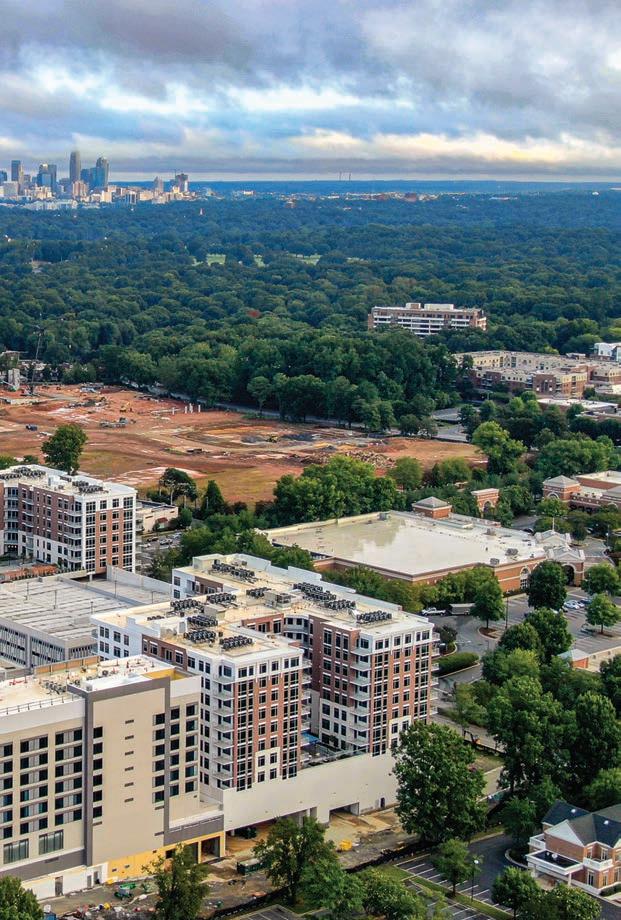
insurance giant Centene announced in July massive plans for its East Coast regional headquarters and technology hub on an 80-acre site in the University City area. This project is expected to employ more than 6,000 workers with average salaries of more than $100,000 a year, Centene reported.
The Centene deal is just the tip of the iceberg. There is an estimated $3 billion in new developments in the pipeline just in Center City, defined as Uptown, South End and Midtown areas, according to Charlotte Center City Partner 2021 State of the Center City Report.
Similarly, more than 5.9 million square feet is under construction in the market, according to JLL. The Charlotte region has sustained “incredible interest from institutional investors subscribing to the promise of Charlotte,” Charlotte Center City Partners President and CEO Michael Smith told Invest:.
Investors recognize the long-term success inherent in the Charlotte market. Currently in the planning and initial development phases of its East-West Station project, San Francisco-based Shorenstein Property is among the many developers turning to the Queen City for opportunities. “Our plan is to build a 375,000-square-foot office building along with a parking garage and retail sitting right on the light rail line,” Shorenstein Properties Managing Director of Investments for Group East Matt Knisely told Invest:. “There is no question that 2020 was a challenging year, but Shorenstein has always taken a long-term approach to investing. Our view is that these long-term investments that we’ve made in cities that we find particularly attractive, like Charlotte, will bear fruit.” The East-West Station project is one of three projects Shorenstein Properties has planned in the Queen
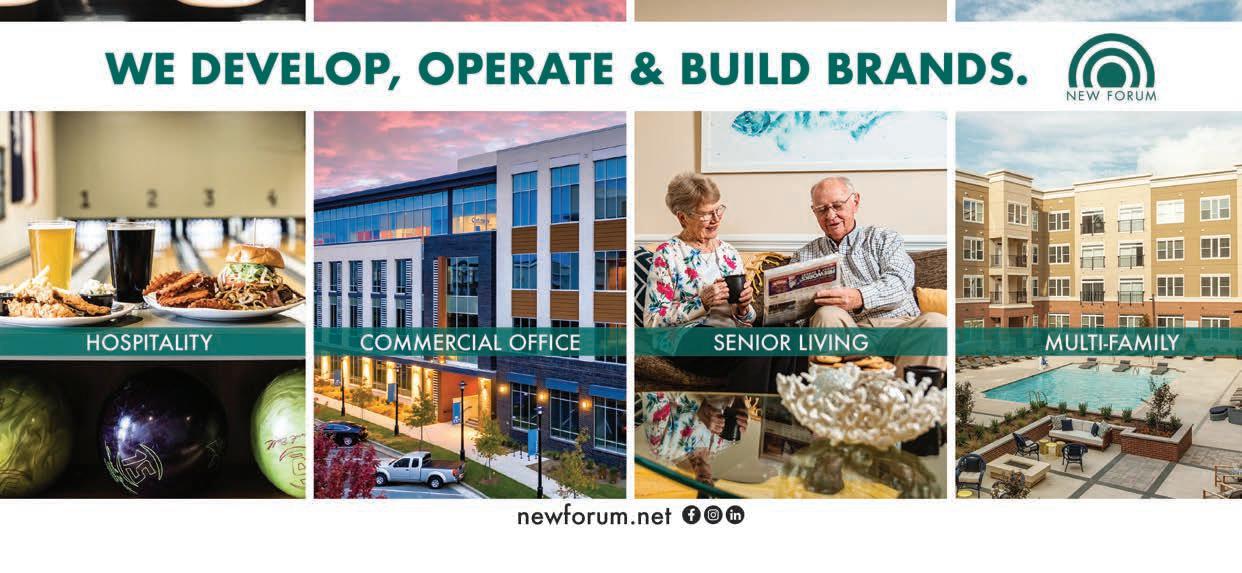
Charles Hodges
President & CEO New Forum

What makes Ayrsley and Southwest Charlotte unique?
When we got involved with Ayrsley, Southwest Mecklenburg County was the second-largest business district in the Carolinas. Interestingly, the district had no discernable urban center or nucleus. Essentially, Ayrsley became that. We provided the services that were needed for many business in our part of town. Southwest Charlotte has some really large campus employers; Siemens, Microsoft, and Spectrum top the list. Those companies need places for their people to eat lunch and dinner and hotels for their out-of-town business guests. Ayrsley meets those needs.
What’s going to happen next?
We’re getting pretty close to being built out in Ayrsley. We’re asking ourselves the big question that most folks in commercial real estate are asking: what’s going to happen with workforces and companies and how they work? I think we’re going to see a new order after the pandemic. I’m not as pessimistic as some or as optimistic as others. We’re trying to figure out exactly how companies are going to attract their workforce and how o ce space will look in the future. We’re also looking at interest rate volatility, valuations, tax strategies, inflation / deflation and alternative investments. We think there will be some significant new drivers influencing real estate over the next five to ten years and we’d like to understand those dynamics.
Is the shopping center model still viable?
That’s actually worked out pretty well for us; groceryanchored centers and fast, casual dining have fared pretty well during the pandemic. We look for existing assets where we can add value by repositioning, architectural modifications, marketing and leasing. We like what we’ve acquired so far, and it’s a lot less of a headache than ground-up development, as long as you can get things done at a reasonable price.
City. “There is a significant contingent of people and companies moving to Charlotte and we are investing accordingly, and are excited about what we can create here over 2021 and for many years to come. We have found the Queen City to be open and welcoming to new companies, new businesses and new people, and we are pleased to provide high-quality office spaces to this growing city,” Knisely said.
The pandemic also fostered time and effort to better make use of Charlotte’s current and historic assets. For example, ATCO Properties & Management Camp North End project, a mixed-use development just outside of Uptown is reimagining the fabric of Charlotte’s past for success moving forward. “The vision is to reimagine a collection of industrial buildings that are incredibly rich in both history and character, as a new and modern space for offices, retail, food and entertainment,” Development Director Tommy Mann said about Camp North End. As companies consider the return back to the office, creating a working environment that reflects a tangible representation of their brand that employees will interact with on a dayto-day basis will be key moving forward, Mann said. “Companies that recognize the importance of that will choose a product like what we’re offering at Camp North End. Adaptive reuse space has so much more character and is such an energizing space for workers,” he said.
There undoubtedly will be winners and losers coming out of the pandemic for the commercial real estate sector. Yet, despite the cyclical nature of commercial real estate, potential investment opportunities may still be present in the local market. “Banks are beginning to see an increased flow of ( )
Brannen Edge
Managing Partner, President & Chief Executive Officer Flagship Healthcare Properties
As we evaluate our markets, we are invested in 10 states in the Southeast and Southern Mid-Atlantic region. We want to grow our investment across all those markets. Looking at submarkets, there are a lot of important factors, such as size, population growth, senior population growth, levels of insurance coverage, the number of healthcare systems and the presence of certificate of need laws. We also look at economic trends, including how unemployment rates will rebound and where they will lag. We’re looking closely at changes to the A ordable Care Act and how that will change the outlook. Generally, any development that expands access to healthcare is good for our business.
In addition to Northmarq’s private ownership and amazing access to capital, the trust within and collaborative nature of our team is the main di erentiating factor. Our deep client relationships are unmatched because we are the result of two very dominant teams coming together. Clients hire us because we are advisors first and foremost, work as a pack, and are extremely well-coordinated. We don’t focus on volume; we focus on quality, and we are able to deliver superb results through a true team e ort that we believe is unmatched in terms of trust, comradery, and partnership. Andrea Howard
Managing Director of Investment Sales Northmarq
Jared Londry
Co-Market Leader & Executive Managing Director Stream Realty Partners
I would never count Northwood out. Ballantyne is established and it’s such a great place already, so people might not view that as up and coming, but I think Ballantyne is going to look like Buckhead in 5 years, and in 10 years, we might have tra c like Buckhead in Ballantyne. Overall, the perception and desirability of Ballantyne is going to change dramatically just because of what John Barton and team are doing.
Outside of that, Fort Mill has seen a huge amount of growth, looking at the other side of the border. And if you are looking more infill, urban locations, the Music Factory still has a lot of opportunity in the o ce and multifamily side because it’s so close to Uptown. That, and Freemore West, on the backside of Uptown, will all feel much more connected as the growth continues.
There are definitely hot pockets of growth and continued speculative construction. The State Line Industrial submarket, located at the southernmost portion of Mecklenburg County, as well as the York County, SC submarket have experienced tremendous demand. Similarly, the Cabarrus County Industrial submarket has been desirable to logistics firms like Amazon, which now leases over 1,500,000 SF of warehouse space in nearby Concord. The connectivity provided by access to I-85, I-77 and I-40 is highly desirable to logistics firms. Karen Mankowski
Associate Director Newmark
An emphasis on health and safety and workforce flexibility is likely to characterize companies’ o ce return strategy. ( ) real estate owned (REO) assets coming into their portfolios,” Coldwell Banker Commercial MECA President Rob Pressley told Invest:. “One of the services we provide in our asset management group is lender representation in the management, marketing and disposition of REO assets as they foreclose on commercial and land. Our largest bank client is one of the Top 10 banks in the country. We manage their entire U.S. REO portfolio out of Charlotte. We are already seeing an influx of properties coming into that portfolio of foreclosed assets. We will be focusing a lot of our energy as we did in 2009-11 on the management and disposition of REO assets. We don’t fear a down or softened market. Opportunities are available that are not present in a good market. We have a lot of investors who have been sitting on the sidelines with a lot of capital who are looking to invest and take advantage of assets that maybe will begin to become either realistically valued or even undervalued going forward,” Pressley said.
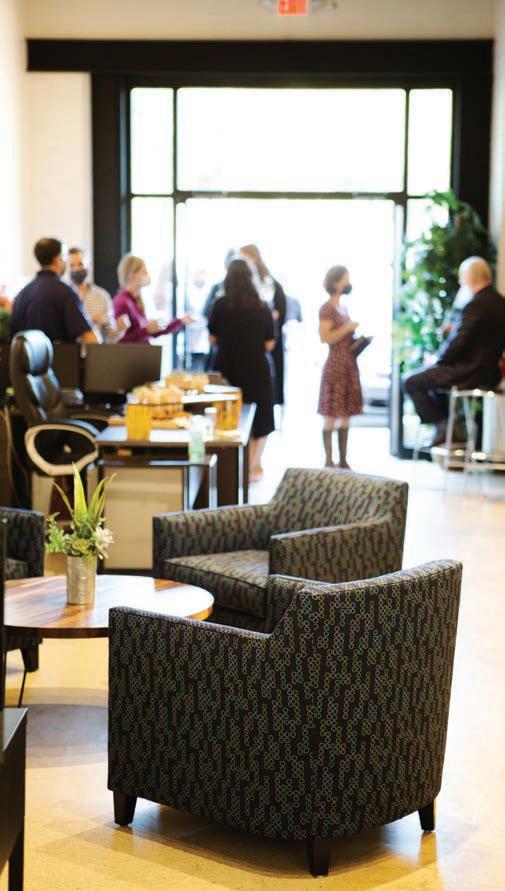
Industrial The industrial sector was a beacon of light for the commercial market in a year clouded by uncertainty and challenges for the sector at large. The local industrial market capped off a tumultuous year on a high note, with 2 million square feet of positive net absorption in Q4 alone, bringing the 2020 total to 5.3 million square feet, up 123% over 2019, according to Avison Young’s 4Q20 industrial market report. More than 7.6 million square feet of new space was delivered in 2020, and Charlotte’s inventory has grown by 15% in the last five years, Avison Young noted. Charlotte’s

Sandor Scher
Principal – Claro Development
I think there’s a lot of work that can be done in a constructive way on the planning front. Historical preservation is incredibly important, it’s been our bread and butter for the last 15 years. We need to evolve and finding ways to incentivize development from a planning perspective as opposed to penalizing and restriction is a fundamental paradigm shift that needs to happen, although it’s not an easy task for politicians and planners. The old version of historic preservation without connecting the properties to modern development requirements and the changing needs of our guests is simply not an e ective long term strategy.
investments over the last decade mixed with scale projects announced in the latter. Gaston is on our availability of land in key submarkets positioned the radar in part because we have an office there. Being just industrial market for a strong performance in 2020. over the North and South Carolina line, York-Lancaster
As of the end of 1Q21, total vacancy sat at 5.8%, is the third big region that has been in high-growth according to JLL’s 1Q21 industrial market report. mode. The NFL’s Panthers are not only relocating their Though demand remains high for the sector at large, headquarters but also building a massive campus that rents remain mostly flat at $4.82 per square foot would include a medical office, retail, hotel and new for direct asking rent and $5.14 per square foot for exits being built on I-77 just over the state line. York sublease asking rent. According to data by JLL, the and Gaston will continue to see a monster amount of region has 2.3 million square feet already committed growth,” he said. to move-in dates through the The boom in e-commerce is exend of the year. The I-85 and I-77 corridors have York and pected to drive investment opportunities in the Charlotte market. become hotbeds for build-to-suit Gaston will However, the main challenge and speculative industrial real estate space. York and Gaston coun- continue to to the market’s health could be keeping up with demand. As of ties particularly have attracted a great deal of demand thanks see a monster 1Q21, there was 6,995,981 square feet of new construction underto their proximity to Charlotte amount of way, JLL reported. If industrial proper and key locations along the interstates. York County’s 1.9 growth space cannot quickly meet the market demand, JLL warned, million and Eastern County’s 1.2 Rob Pressley users and developers might eye million square feet led submarket President, Coldwell Banker Commercial MECA other Southeast hotspots to place construction activity, according their requirements and capital. to JLL. As a result of the explosion of e-commerce in The Charlotte industrial market, strong in the last couple of years, and its acceleration during warehouse, logistics and manufacturing companies, the pandemic, more users are seeking locations in the could become a viable destination for the life sciences city of Charlotte and surrounding towns to position sector, a sector dominated by sister market, Raleighlast-mile distribution centers to serve their in-town Durham. The upcoming medical school, a joint effort customers, JLL reported. “The two (hotbeds) that by Atrium Health and Wake Forest University, will stand out right now are York County to the south and further bolster the market’s already strong medical Gaston County,” Coldwell Banker Commercial MECA’s sector while ushering in new opportunities for local Pressley told Invest:. “There have been some large- life sciences companies and in turn the industrial real

David Kennedy
President Canopy Realtor® Association

How would you sum up Charlotte’s residential market?
What we see is that the same types of homes that were bought and sold on Canopy MLS prior to the pandemic are still being bought and sold during the pandemic, with the exception of maybe a pause in the market at the onset of the Pandemic. July and August were recordbreaking. The market continues to be challenged by a lack of inventory. The thing we have to understand about inventory is that people from all over are moving to Charlotte. During the recession in 2008-9, a lot of people lost their house. The housing industry and the builder’s construction industry both took a major hit because of that. Medium-sized builders and the smaller builders vanished. From 2010 all the way up to 2021, without fail, the household growth has outpaced construction on a national level. Charlotte is a desirable place to move to. People are moving from the Northeast and Atlanta to Charlotte. The di erence between the Charlotte, Atlanta and Northeast markets is that the cost of living is higher than in Charlotte, so people have more purchasing power. They are willing to pay more and raise the price levels because they think they’re getting a great deal based on where they were living. When supply and demand are imbalanced, such as they are now, the cost of everything going up is not necessarily a good thing because if you could just introduce more inventory, you would flatten out the prices.
What is your near-term outlook?
The fog will start to clear once we start seeing certain things, in particular herd immunity, pre-pandemic unemployment rates and stabilized inflation. It will be 4Q21 before we can see any of that happen. Five million millennials are going to turn 30 this year. These are mortgage-ready millennials. They are the most educated, equipped generation we’ve ever had. They didn’t rush into life-altering decisions such as buying a house they could not a ord. The problem is going to be lack of inventory.

Charlotte’s diversifying economy is set to open the door for the proliferation of new industries such as life sciences.
estate sector. “We’re strong in medicine, but we’re not strong in life sciences yet. Our new medical school by Atrium Health and Wake Forest will change that,” City of Charlotte Economic Development Director Tracy Dodson told Invest:.
A recent report on the state of the life science industry echoes Dodson’s sentiments. The Charlotte market topped JLL’s list of emerging life sciences markets in the United States, according to the brokerage’s 2021 Life Sciences Emerging Markets Index report. “For an emerging life sciences market to reach full maturity, talent and momentum must combine and synthesize. The best way to ensure that is to provide the foundation for an appealing long-term lifestyle for young professionals, so that they will put down roots and spend their prime career years nurturing the local life sciences ecosystem,” JLL reported. Assessing recent
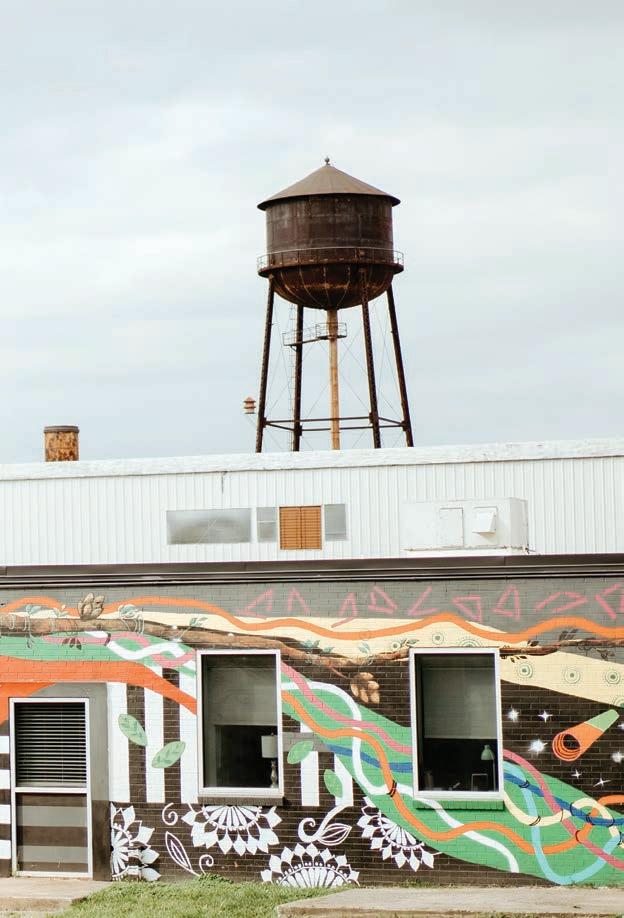
GDP growth, millennial population growth projections, income and housing stock growth, the Charlotte market ranked the highest in potential to attract and retain life science professionals, beating markets such as Seattle, Denver, Austin and Nashille.
Looking ahead Despite a challenging cycle, the Charlotte real estate market has rolled with the pandemic challenges thanks to years of continued investments, economic diversification and growth, and continued population growth. Developers, investors, businesses and individuals will need to keep a close eye on the cyclical nature of real estate mixed with ripple effects of the pandemic to maximize opportunities in the Charlotte market. From residential to certain commercial asset classes, the low supply in inventory may create challenges and disrupt investment plans. Conversely, the low-interest environment and the market’s 16 county metropolitan area opens up opportunities for corporations and individuals alike.
Outside of the COVID-related market uncertainty, the Charlotte market is working to improve challenges related to affordable housing and upward mobility via its strong public and private collaborative efforts, which will be critical as the region grows. The region’s robust workforce, diversifying economy, proven track record of attracting companies large and small make it one of the most attractive markets along the Sun Belt. Emerging out of the COVID landscape, the Queen City is poised to be a treasure chest of opportunities for current and new businesses and families looking for a dynamic region to live, work and play.









